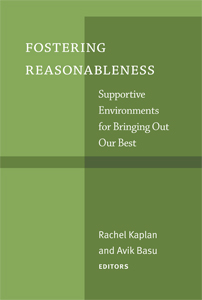
Fostering Reasonableness: Supportive Environments for Bringing Out Our Best
Skip other details (including permanent urls, DOI, citation information): This work is licensed under a Creative Commons Attribution-NonCommercial-NoDerivatives 3.0 License. Please contact mpub-help@umich.edu to use this work in a way not covered by the license.
For more information, read Michigan Publishing's access and usage policy.
Part I. Foundations of the Reasonable Person Model
Road Map to Part I
As presented in Chapter 1, the three major domains of the Reasonable Person Model (RPM) are highly interrelated. These domains are further developed in the chapters in this section. The first two chapters focus on the mental model domain. Rachel Kaplan’s chapter discusses how mental models develop and the wide-ranging challenges of sharing our mental models. Stephen Kaplan’s emphasis on expertise provides many insights into how gaining knowledge and experience, while essential to so many efforts, can also impede sharing models. William Sullivan’s chapter focuses on RPM’s second domain—being effective—with special emphasis on the role of clearheadedness in our functioning effectively. The final two chapters in the section further develop the essential roles of each of the RPM domains but in the context of crosscutting issues. In the case of J. Eric Ivancich’s chapter, the topic is clarity, a compelling albeit fleeting pleasurable state that we humans much prefer to confusion or boredom. Avik Basu’s chapter looks at RPM in the context of better understanding ourselves.
It is not only the development of the core RPM concepts that brings these chapters together. To a surprising degree, each chapter provides rich imagery of how much these core issues are invisible to us. We take our functioning for granted and understand it poorly. That is both unavoidable and unfortunate. It is unavoidable because it is difficult both to function and to watch ourselves functioning. It is unfortunate because bringing out the best in others and ourselves would be greatly augmented if we realized the workings of our mental models, the role of clarity, the costs of spending our limited attentional resources, and the ways we can create environments that are more supportive of our needs.
Chapter 2: Rachel Kaplan, “The Joys and Struggles of Building Mental Models”
Rachel Kaplan’s chapter addresses model building, the first domain of RPM. That we all share the same neural hardware suggests that many aspects of the model-building process are universal. We all find pleasure in making sense of the world and struggle when that sense escapes us. Avoiding such confusion requires multiple and varied experiences in order to develop understanding as well as safe opportunities for exploring to expand that understanding. In addition to these processes, the chapter addresses the related challenge of information sharing, an issue that is relevant to many chapters in the book and to many human endeavors. A key insight of the chapter is that sharing information is not about delivery but rather helping others build mental models.
Chapter 3: Stephen Kaplan, “The Expertise Challenge”
Inescapably, we are all experts. We are also often blind to the costs of that expertise. Similarly, we all benefit from others’ expertise and are often frustrated by the barriers it can create. Stephen Kaplan shows us that many of these costs and benefits are essential to gaining the familiarity and knowledge that expertise entails while also pointing to some cognitive adjustments that might bring out the best in experts and the nonexperts with whom they share information.
Chapter 4: William Sullivan, “In Search of a Clear Head”
Attention is a key, but limited, resource for human effectiveness. William Sullivan’s chapter demonstrates how pervasively we use this resource and how damaging it can be when our attention is fatigued. While certain kinds of environments can be a drain on attention, others can help restore it. The interconnectedness of the RPM domains is apparent in this chapter—maintaining our attentional resources can impact how well we are able to build mental models and whether we have the energy to engage in meaningful acts.
Chapter 5: J. Eric Ivancich, “Fostering Clarity to Achieve Reasonableness”
Boredom and confusion are mental states we try to avoid. The pleasure of clarity, by contrast, while perhaps not as evident, is also a compelling motivation. Eric Ivancich shows how these concepts are pivotal to reasonableness, basic to RPM, and applicable to the remaining chapters in this volume. Opportunities for enhancing clarity are far-ranging and far-reaching yet frequently unrecognized. Creating supportive environments can take advantage of this when information is shared in a way that anticipates and manages people’s boredom, confusion, and clarity.
Chapter 6: Avik Basu, “Bringing Out the Best in Ourselves”
Avik Basu’s chapter shows both how complex the quest for self knowledge can be and how useful RPM can be in developing multifaceted ways to address it. In the process he helps us understand RPM in terms of its many embedded qualities that invisibly come together as we go about life. Gaining a better sense of ourselves involves a great deal of exploration and assessment. To whatever degree we tackle these opportunities, we are bound to bring out our better selves and, at the same time, contribute to the reasonableness of others.


